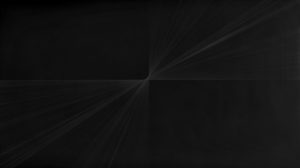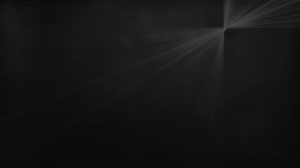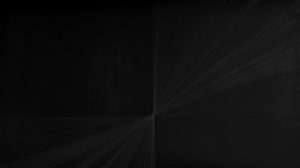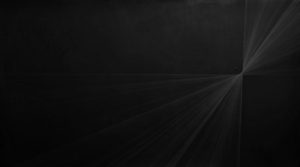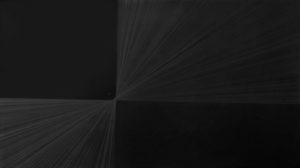In making the work, Larson used a strip of metal to trace each individual line, a threshold of the kind conventionally used to cover the place where rooms abut, where wood floor meets carpet, to mark and mask transitions from one space to another. Repurposed, the tool becomes a drawing device that is rotated around a single nail in minuscule increments and followed, diligently, by line after line. The intersection of hundreds of lines creates the geometric illusion of a dramatic turning point: up close, they cluster into a partial circle; closer still, it seems as though the lines converge to flip space itself. They upend linear perspective’s plane of consistency and render orientation in space precarious. Unlike flight lines that reliably organize the depth of space, Larson’s lines create a moment of passage from one plane to another. Void of other reference points, the intersecting lines trick the eye into perceiving two separate spaces at once. Uprooted from a single point of view, the gift of this point is no longer concealed in the moment of being received as given: “Depending on which way one turns, different worlds might even come into view.”
Besides troubling spatial perception, the threshold as turning point interrupts the duration of each line and thus conjures a sense of time. All of a sudden, there is a before and an after. Yet while distinct, a difficulty remains in discerning their relative sequence, a difficulty that extends to the drawing of the line itself. “A paradox of the footprint emerges,” writes Sara Ahmed. “Lines are both created by being followed and are followed by being created. The lines that direct us, as lines of thought as well as lines of motion, are in this way performative: they depend on the repetition of norms and conventions, of routes and paths taken, but they are also created as an effect of this repetition.” Literal lines thus take a turn to metaphor.
To trace each line, Larson walked alongside the length of the would-be drawing in a choreography dictated by material, scale, the placement of a single nail, and momentum of movement. Each work thus bears the traces of an ephemeral performance and embodies the residue of gestures oft repeated. But despite holding such memories of a body’s movement, Larson’s lines are not expressive; despite pale graphite lines racing towards an illusory turning point, a stillness pervades the drawings, reminiscent of the calm that comes with observation from great distance. Imagine light rays creeping through interstellar darkness, their speed a measure of distance dwarfed by cosmic proportions. Yet the suggestion of vast expanses coincides with the up-close intimacy the threshold as turning point urges and with the lingering material presence whose fulcrum is the single nail. The drawings hover on the brink where each register of engagement, aloof and proximate, is equally possible, each space equally accessible. Their dark poetry dwells on the cusp of things to come.
